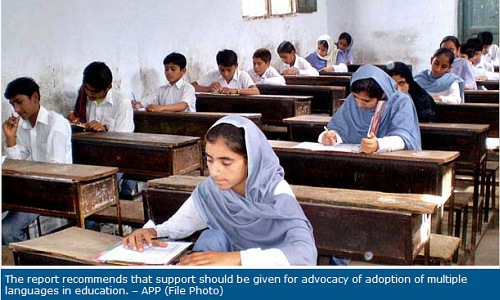Mother tongue first

A fascinating report released recently by the British Council Pakistan on the role of language in education in Pakistan, suggests that Pakistani students are best served by education if they are to be instructed in their mother tongues.
The report also suggests that Islamic madrassas are extremely interested in learning English so they can promote Islam in other countries, learn about other religions, communicate their message to the world in a better way, improve image of Islam in the world as well as the basic need for Muslims to learn knowledge.
Titled Teaching & Learning in Pakistan: The Role of Language in Education, the report (prepared by Hywel Coleman and the British Council), was based on the results of a widespread research and survey of the many languages spoken in Pakistan and the country’s education sector.
Some of the findings in this context are:
- Language breakdown of Pakistanis by mother-tongue are: (Punjabi) 49.3 %, Pushto 12.0 %, Sindhi 11.7%, Urdu 6.8%, Balochi 3.6%, Brahui 1.3 % and Farsi 0.6 %.
- Urdu tends to remain the medium of instruction except for a few English schools.
- Class 3 students are not able to write simple sentences in Urdu and do not recognize simple words in English. They are in effect functionally illiterate and innumerate.
- English is involved in two contexts: as a subject, as the medium of instruction
- While intention is good for use of English as medium of instruction, its impact is negative.
The report insists that education in mother tongue is more effective especially in early years because:
- There are no barriers to comprehension as formulation of basic concepts takes place in mother tongue.
- Children learn to read and read more quickly and easily in a language they are already familiar. Making connections between sounds of a language and signs on a written page is more effective when those sounds are repeated more often.
- The same language spoken at home, so learning can be reinforced. This also enables the parents to get involved and monitor and contribute to children’s education.
- Children can relate their learning in school with their home environment, the games they play, the TV programs they watch, their interaction with other students if all of this is in the same language.
- All communities feel equally respected if their home languages are employed. Using a language in school that people do not understand leads to political and social instability and conflict. Particularly important for Pakistan as it is one of 11 countries with high levels of “fragility of conflict” and one of 19 countries with high linguistic fractionalisation
- Survey of 22 countries suggests that choice of first language affects educational attendance, performance and explains half of the reason for low retention rates. This is particularly relevant for women.
- All things being equal, children are likely to achieve greater proficiency in English if they first study in their home language and then study English as a foreign or second language.
- Only 5 % of Pakistanis have access to education in their first language.
The report thus recommends that support should be given for advocacy of adoption of multiple languages in education. But it also notes that education in multiple languages is logistically difficult to arrange for in Pakistan. However since the seven major languages in Pakistan are first language for 85 pe rcent of the school population, these can be used as medium of instruction right at the start.
The report points out that international experience suggests that adoption of multiple languages for primary education strengthens loyalty of ethnic minority towards the state.
Based on these findings, the report then goes on to make some potent recommendations for education in Pakistan till the year 2020.
The following is how the recommendations have been devised:
- Nursery Education : Learn to speak mother tongue language
- First 3 years: Introduction to alphabets, learn to read and write in their mother tongue. (Scripts for local language and Urdu are either same or very similar.)
- Class 3-5 : Urdu is introduced and gradually replaces regional language as the language of instruction. By 5 this transition is complete. Regional language is a subject not medium of instruction but still taught as a subject.
- Class 6: Children should be confident and fluent in Urdu by now. Roman alphabet and English are introduced. English is studied as a main subject for four years (grade 6-9)
- Class 10: English becomes medium of instruction; Urdu and regional languages become subjects.
- Entrance exams for civil service, other employment and universities will require that candidates are good in all 3 languages (Urdu, English, regional language). This will help them serve their people better and oblige elite schools to teach local language.
The British Council report will be officially launched on Thursday.